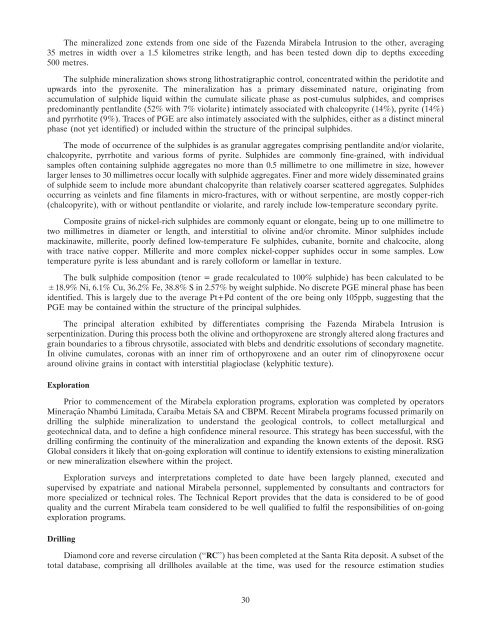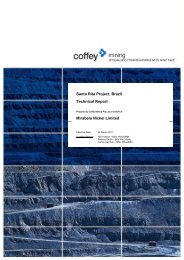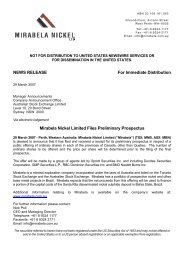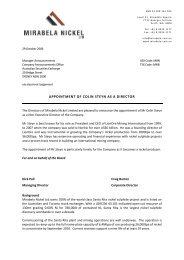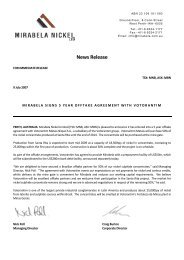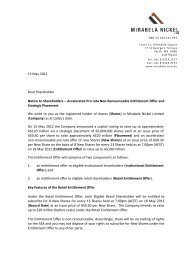COPY OF FINAL PROSPECTUS - Mirabela Nickel
COPY OF FINAL PROSPECTUS - Mirabela Nickel
COPY OF FINAL PROSPECTUS - Mirabela Nickel
Create successful ePaper yourself
Turn your PDF publications into a flip-book with our unique Google optimized e-Paper software.
The mineralized zone extends from one side of the Fazenda <strong>Mirabela</strong> Intrusion to the other, averaging<br />
35 metres in width over a 1.5 kilometres strike length, and has been tested down dip to depths exceeding<br />
500 metres.<br />
The sulphide mineralization shows strong lithostratigraphic control, concentrated within the peridotite and<br />
upwards into the pyroxenite. The mineralization has a primary disseminated nature, originating from<br />
accumulation of sulphide liquid within the cumulate silicate phase as post-cumulus sulphides, and comprises<br />
predominantly pentlandite (52% with 7% violarite) intimately associated with chalcopyrite (14%), pyrite (14%)<br />
and pyrrhotite (9%). Traces of PGE are also intimately associated with the sulphides, either as a distinct mineral<br />
phase (not yet identified) or included within the structure of the principal sulphides.<br />
The mode of occurrence of the sulphides is as granular aggregates comprising pentlandite and/or violarite,<br />
chalcopyrite, pyrrhotite and various forms of pyrite. Sulphides are commonly fine-grained, with individual<br />
samples often containing sulphide aggregates no more than 0.5 millimetre to one millimetre in size, however<br />
larger lenses to 30 millimetres occur locally with sulphide aggregates. Finer and more widely disseminated grains<br />
of sulphide seem to include more abundant chalcopyrite than relatively coarser scattered aggregates. Sulphides<br />
occurring as veinlets and fine filaments in micro-fractures, with or without serpentine, are mostly copper-rich<br />
(chalcopyrite), with or without pentlandite or violarite, and rarely include low-temperature secondary pyrite.<br />
Composite grains of nickel-rich sulphides are commonly equant or elongate, being up to one millimetre to<br />
two millimetres in diameter or length, and interstitial to olivine and/or chromite. Minor sulphides include<br />
mackinawite, millerite, poorly defined low-temperature Fe sulphides, cubanite, bornite and chalcocite, along<br />
with trace native copper. Millerite and more complex nickel-copper suphides occur in some samples. Low<br />
temperature pyrite is less abundant and is rarely colloform or lamellar in texture.<br />
The bulk sulphide composition (tenor = grade recalculated to 100% sulphide) has been calculated to be<br />
18.9% Ni, 6.1% Cu, 36.2% Fe, 38.8% S in 2.57% by weight sulphide. No discrete PGE mineral phase has been<br />
identified. This is largely due to the average Pt+Pd content of the ore being only 105ppb, suggesting that the<br />
PGE may be contained within the structure of the principal sulphides.<br />
The principal alteration exhibited by differentiates comprising the Fazenda <strong>Mirabela</strong> Intrusion is<br />
serpentinization. During this process both the olivine and orthopyroxene are strongly altered along fractures and<br />
grain boundaries to a fibrous chrysotile, associated with blebs and dendritic exsolutions of secondary magnetite.<br />
In olivine cumulates, coronas with an inner rim of orthopyroxene and an outer rim of clinopyroxene occur<br />
around olivine grains in contact with interstitial plagioclase (kelyphitic texture).<br />
Exploration<br />
Prior to commencement of the <strong>Mirabela</strong> exploration programs, exploration was completed by operators<br />
Mineração Nhambú Limitada, Caraíba Metais SA and CBPM. Recent <strong>Mirabela</strong> programs focussed primarily on<br />
drilling the sulphide mineralization to understand the geological controls, to collect metallurgical and<br />
geotechnical data, and to define a high confidence mineral resource. This strategy has been successful, with the<br />
drilling confirming the continuity of the mineralization and expanding the known extents of the deposit. RSG<br />
Global considers it likely that on-going exploration will continue to identify extensions to existing mineralization<br />
or new mineralization elsewhere within the project.<br />
Exploration surveys and interpretations completed to date have been largely planned, executed and<br />
supervised by expatriate and national <strong>Mirabela</strong> personnel, supplemented by consultants and contractors for<br />
more specialized or technical roles. The Technical Report provides that the data is considered to be of good<br />
quality and the current <strong>Mirabela</strong> team considered to be well qualified to fulfil the responsibilities of on-going<br />
exploration programs.<br />
Drilling<br />
Diamond core and reverse circulation (‘‘RC’’) has been completed at the Santa Rita deposit. A subset of the<br />
total database, comprising all drillholes available at the time, was used for the resource estimation studies<br />
30


